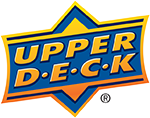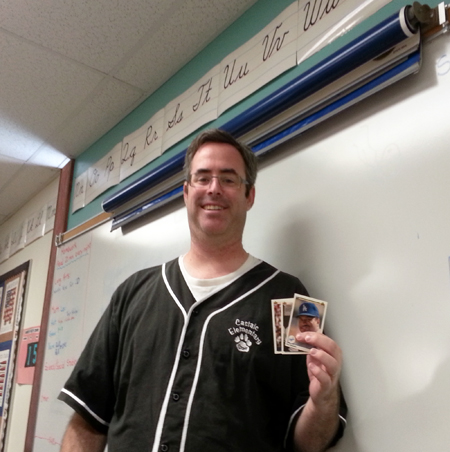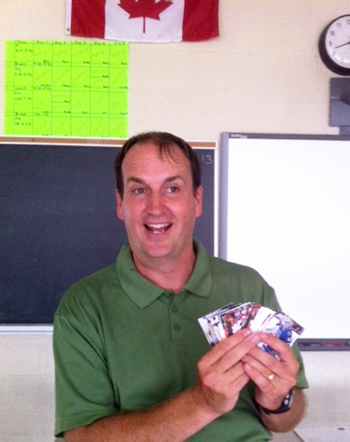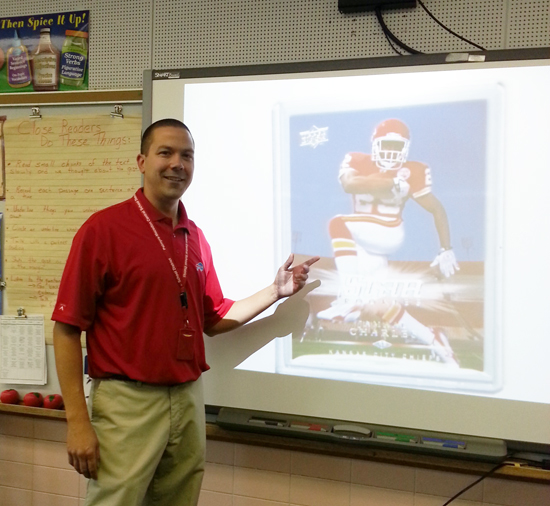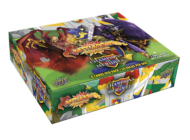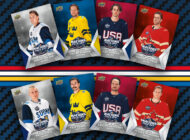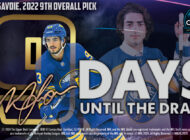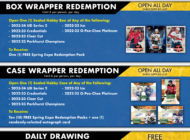My major in college was elementary education so I always felt there was tremendous potential to using manipulatives like trading cards with students to help them learn math, reading, writing, art, history, political science, physical education and more. Quite simply the use of Upper Deck cards in the classroom makes learning fun for the students and as they engage with the cards they sometimes don’t even realize they happen to be learning as well.
Recently Upper Deck ran a promotion for teachers to submit lesson plans to the company to receive some cards for their classroom. We felt inclined to share three of our favorites to encourage other educators to give them a try in your classes. Whether it is baseball, football, hockey, basketball or golf, there are a variety of opportunities to teach using trading cards.
Additionally I would highly encourage any educators to check out Upper Deck’s Goodwin Champions sets from over the years which have a variety of very interesting content that can be used as a teaching tool like the Wonders of the Universe set, the Animal Kingdom patch cards, the Museum Collection, the Art of the Ages set, the Elements set, the Military Machines set, the Entomology set, the “It Came From Outer Space” meteorite cards and much, much more.
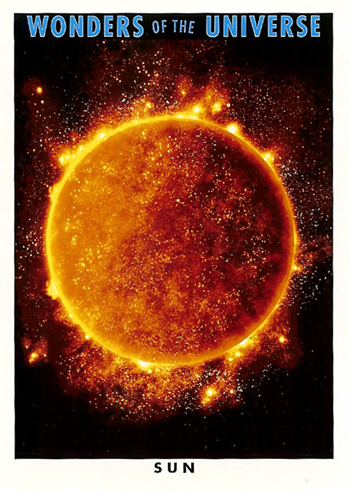
Upper Deck has made a push with the Goodwin Champions set to create interesting new themes for trading cards that can also be used for educational purposes like the Wonders of the Universe set which has compelling imagery and great facts on the heavenly body shown.
Joshua Levine – Castaic Elementary School – 4th Grade
“Baseball Cards in the Classroom”
Time: Monthly during math time, approx. 11:00 am.
Title: Baseball Card Math
Subject: Math
Cross-Curricular: Social Studies, Vocabulary
Objectives: The students will use statistics on the back of the provided baseball cards to answer questions, practice math facts, and critically think.
Materials Needed: Baseball cards, paper, pencil, math facts cards
Anticipatory:
Prior to starting these lessons, there will be a discussion of math in sports, specifically baseball. The students will have also completed the unit on statistics and long division. The teacher will demonstrate how to find batting average (hits/at-bats), earned run average ([earned runs/innings pitched]x9), and whip(walks + hits/innings pitched). The students will be taught the formulas for these and they will be posted in the classroom.
Lesson:
Whole group: The teacher will use two baseball cards (one position player and one pitcher) that he enlarged and copied for the class as an example. The teacher will go over the parts of the card (both front and back) and review the statistics on the back of the card. As a whole class, the students will use the statistics on the back of the card to find ERA, WHIP, and BA using the formulas given. The teacher will walk them through the steps a few times and compare their answers to those printed on the baseball cards.
Small group:
The teacher will then pass out several real baseball cards to the tables. The students will work in table groups to check the stats on the back of the cards showing their work on paper.
Assessment:
Informal: The teacher will walk around and do a work check while the students are working in groups.
Formal: A quiz will be given that asks the students to look at the back of two copied baseball cards with certain statistics blacked out. They are then to find the missing statistics using the formulas and math facts they have learned.
Post-Assessment:
This project is done several times a year. The motivation is that the students get to keep the baseball cards they used in the table groups.
Standards: Science 1a.
Brett Davis – Harry J. Clarke Public School – 7th Grade
|
Curriculum Expectation |
|
| By the end of Grade 7, students will collect data by conducting a survey oran experiment to do with themselves, their environment, issues in their school
or community, or content from another subject and record observations or measurements. |
|
| By the end of Grade 7, students will read, interpret, and draw conclusions fromprimary data (e.g., survey results, measurements, observations) and from secondary
data (e.g., temperature data or community data in the newspaper, data from the Internet about populations) presented in charts, tables, and graphs (including relative frequency tables and circle graphs); |
Essential Questions
Students will analyze and create a series of questions regarding their observations of the data found on the back of various sports cards. The questions will be guided by the teacher toward the area of calculating average and being able to fairly compare players who play different amounts of games, or positions or look at points versus goals or assists. Students will guide their own learning throughout the process.
Opening Activities
- Students will begin by opening a pack of hockey card so that they have a random player selection. The teacher will ensure that the cards have adequate statistics for the students to use for comparison. (Hint: Upper Deck tends to have the full compliment of statistics required for this activity)
- The teacher will lead a discussion about which student has the best player in their package of cards. The teacher will challenge students to justify what criteria they used to make their decision.
- The teacher will then choose two players to highlight their statistics on the front board to generate a group discussion. (Hint: Ideally the players should have conflicting statistics such as high goals versus high assists, high number of games played to low number of games played.)
- Students will begin by identifying various short forms and data contained on the cards they receive.
- Students will then compare their players to determine who has scored the most goals, assists and total points.
- Students will review how to calculate average. They will then be asked to calculate the averages of the player cards they are provided with.
- Students will write their players average on a chart paper at the front of the room.
- Together the class will analyze the results and determine whether the number of games played can affect results. Students will also be charged with setting a minimum cut off for number of games played for the statistic to fair and comparable.
Student Objectives (Outcomes)
Performance Tasks
- Students will use the data found on the back of the cards and/or packages to calculate the odds of receiving a special card.
- Students will compare player statistics to determine the point per game for the various players and determine which player has the highest points per game average.
Assessment Evidence
- Students will demonstrate an understanding of calculating averages and comparing results between players by written evidence.
- Students will use mathematical reasoning to justify answers and compare data verbally in class discussion.
- Students will generate a series of summary statements based on the results of their mathematical data. (IE Defensemen score less points per game on average, etc.)
- Students will generate generic statements which summarize how average can be changed based on trials (number of games played).
Other Evidence
- Students will demonstrate understanding by utilizing key terms and results in their conversation and various group work activities.
- Students will utilize data to make predictions about potential point, goals and assists a player might achieve in a 1000 game career, 500 game career, etc.
- Students will also compare and analyze the career totals of Wayne Gretzky and see how his numbers compare to players of today.
Extension Lesson Plans
- Students will be asked to generate a personal hockey card. They will be assessed on their ability to apply the artistic concepts covered in visual arts program.
- Students will assess Goaltender statistics to determine how Goals Against Average is calculated.
- Language Arts- Students will generate a written comparison of two players that explains (using statistical analysis) which player they feel is better. Student will generate a proper written response using the Writing Curriculum.
- Students can analyze players from the 1960’s, 1970’s, 1980’s, 1990’s and compare to players today.
Jerry Scoppa – Palmyra-Macedon Intermediate School – 4th Grade
Introduction: Students will receive a package of trading cards. Students will use one card to create a report on the player as well as the city of the team they play for. The report will be using Voicethread.com or Windows Movie Maker to allow for the inclusion of multimedia and sharing the final project over the Internet.
Tasks: Students report out about the player and city involved in their trading card, a virtual travel brochure. The report will include a multimedia presentation that shows the initial player card, important information on the team’s city, a map of the sports complex, a calculation of the travel time by car from Pal-MacIntermediateSchool to that complex, and other information.
Common Core Learning Standards and New York State Standards Addressed:
CCSS.ELA-Literacy.RI.4.3 Explain events, procedures, ideas, or concepts in a historical, scientific, or technical text, including what happened and why, based on specific information in the text.
CCSS.ELA-Literacy.RI.4.4 Determine the meaning of general academic and domain-specific words or phrases in a text relevant to a grade 4 topic or subject area.
CCSS.ELA-Literacy.RI.4.7 Interpret information presented visually, orally, or quantitatively (e.g., in charts, graphs, diagrams, time lines, animations, or interactive elements on Web pages) and explain how the information contributes to an understanding of the text in which it appears.
CCSS.ELA-Literacy.RI.4.9 Integrate information from two texts on the same topic in order to write or speak about the subject knowledgeably.
CCSS.ELA-Literacy.W.4.2 Write informative/explanatory texts to examine a topic and convey ideas and information clearly.
CCSS.ELA-Literacy.W.4.2a Introduce a topic clearly and group related information in paragraphs and sections; include formatting (e.g., headings), illustrations, and multimedia when useful to aiding comprehension.
CCSS.ELA-Literacy.W.4.2b Develop the topic with facts, definitions, concrete details, quotations, or other information and examples related to the topic.
CCSS.ELA-Literacy.W.4.2c Link ideas within categories of information using words and phrases (e.g., another, for example, also, because).
CCSS.ELA-Literacy.W.4.2d Use precise language and domain-specific vocabulary to inform about or explain the topic.
CCSS.ELA-Literacy.W.4.2e Provide a concluding statement or section related to the information or explanation presented.
CCSS.ELA-Literacy.W.4.4 Produce clear and coherent writing in which the development and organization are appropriate to task, purpose, and audience. (Grade-specific expectations for writing types are defined in standards 1–3 above.)
CCSS.ELA-Literacy.W.4.5 With guidance and support from peers and adults, develop and strengthen writing as needed by planning, revising, and editing.
CCSS.ELA-Literacy.W.4.6 With some guidance and support from adults, use technology, including the Internet, to produce and publish writing as well as to interact and collaborate with others; demonstrate sufficient command of keyboarding skills to type a minimum of one page in a single sitting.
CCSS.ELA-Literacy.W.4.7 Conduct short research projects that build knowledge through investigation of different aspects of a topic.
CCSS.ELA-Literacy.W.4.8 Recall relevant information from experiences or gather relevant information from print and digital sources; take notes and categorize information, and provide a list of sources.
CCSS.ELA-Literacy.W.4.10 Write routinely over extended time frames (time for research, reflection, and revision) and shorter time frames (a single sitting or a day or two) for a range of discipline-specific tasks, purposes, and audiences.
CCSS.ELA-Literacy.SL.4.4 Report on a topic or text, tell a story, or recount an experience in an organized manner, using appropriate facts and relevant, descriptive details to support main ideas or themes; speak clearly at an understandable pace.
CCSS.ELA-Literacy.SL.4.5 Add audio recordings and visual displays to presentations when appropriate to enhance the development of main ideas or themes.
CCSS.ELA-Literacy.SL.4.6 Differentiate between contexts that call for formal English (e.g., presenting ideas) and situations where informal discourse is appropriate (e.g., small-group discussion); use formal English when appropriate to task and situation.
CCSS.MATH.4.MD.2 Use the four operations to solve word problems involving distances, intervals of time, liquid volumes, masses of objects, and money, including problems involving simple fractions or decimals, and problems that require expressing measurements given in a larger unit in terms of a smaller unit. Represent measurement quantities using diagrams such as number line diagrams that feature a measurement scale.
NYS.SOCIALSTUDIES.Standard3.KeyIdea1 Geography can be divided into six essential elements which can be used to analyze important historic, geographic, economic, and environmental questions and issues. These six elements include: the world in spatial terms, places and regions, physical settings (including natural resources), human systems, environment and society, and the use of geography.
NYS.SOCIALSTUDIES.Standard3.KeyIdea2 Geography requires the development and application of the skills of asking and answering geographic questions; analyzing theories of geography; and acquiring, organizing, and analyzing geographic information.
NYS.SOCIALSTUDIES.Standard4.KeyIdea2 Economics requires the development and application of the skills needed to make informed and well-reasoned economic decisions in daily and national life.
Process:
Day 1
- Students will observe examples of Voicethreads and Movie Maker presentations.
- Students will observe examples of trading cards, noting the different information included, including connections with Math and writing.
- Hand out the trading card project packets, including the planning pages, rubrics, walkthrough guides to using Voicethread and Movie Maker.
- Hand out trading card packs, team bags, and hard cases to protect the cards. The card the students will used should be placed in the hard case for continual use.
Day 2
- Students will use the observation sheet to record vital card information, including player name, team location, and important statistics or interesting facts.
Day 3-5
- Students will use the planning pages to begin research the cities and sports complex locations via the Internet.
- Using Google Maps, the students will determine the total distance from Pal-MacIntermediateSchool to the sports complex via car. The information should be added to the planning packet.
- Students should make a determination on whether a static Voicethread or a Movie Maker presentation.
Day 6-10
- The students will then proceed with the appropriate guides to create their presentations using Voicethread or Movie Maker.
Day 11-12
Students will present their final project to the class.
Resources:
- Trading card pack per student
- Team bags and hard cases
- Netbooks and iPads with Internet access
- Voicethread.com accounts
- Planning pages packet
- Digital cameras/document cameras
- Microphones
- Digital video recording and digital picture equipment
Evaluation:
- Students will be evaluated on a rubric
- Rubric scores will be on a 1-4 scale
- The rubric will be completed during and immediately following the student presentation of the Voicethread document or digital video presentation.
- Some students may be able to use the presentation to help fulfill badge requirements for Scouts.





